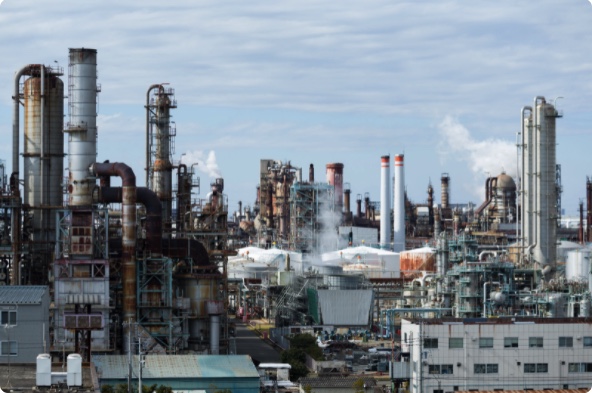
Pension retirement capital at risk from billions invested in liquefied natural gas
May 10, 2024
The U.S. liquefied natural gas (LNG) export industry is growing rapidly, expanding from zero export capacity in 2015 to becoming the largest exporter in the world in 2023.[1] Private equity firms are sinking billions of dollars into building LNG terminals, drawing from fund commitments by public pensions and other investors. Despite the financial and environmental risks associated with the industry, private equity firms have invested heavily in LNG export infrastructure. LNG is also responsible for a high amount of carbon emissions, jeopardizing progress to contain climate change and contradicting the stated climate goals of many invested pension funds.
Public pensions invest across capital markets, meaning that workers’ retirement dollars are exposed to the risks of existing and proposed LNG export terminals in the U.S. through both public and private markets investments. The financial risks facing the U.S. LNG export industry are economic and regulatory and should be considered when pension funds commit to private equity funds investing in this type of harmful infrastructure.
A list of investors that have committed to private equity funds invested in current or proposed LNG terminals is available here.
PESP analyzed existing and proposed LNG export terminals with private equity investments to determine which US public pension funds have exposure to the LNG industry currently and as it expands. Currently, six pension funds have committed over $1 billion each to PE funds that have invested in a US LNG export terminal, including:
- New York State Common Retirement Fund
- New York City Combined Funds
- Oregon Investment Council
- California Public Employees’ Retirement System
- Teacher Retirement System of Texas
- Washington State Investment Board
In addition, four pension funds committed to at least five private equity funds that contain a LNG terminal:
- New York State Common Retirement Fund
- New York City Combined Funds
- Santa Barbara County Employees’ Retirement System
- Oregon Investment Council
Emissions risk
The private equity industry has invested in 85% of currently operating LNG terminals which export approximately 11 billion cubic feet per day (bcf/d) of natural gas to international buyers[2], contributing over 28 million metric tons of CO2e annually (mt CO2e/yr) according to Private Equity Climate Risks (PECR) project research.
Currently, private equity firms are invested in 73% of proposed LNG export terminals in the U.S. If built, all the private equity-backed proposed LNG terminals would emit an additional 68 mt CO2e/yr and export around 26 billion cubic feet per day[3] (bcf/d) more fracked natural gas overseas. Together, the LNG terminals backed by private equity are on track to emit over 96 mt CO2e/yr, the equivalent emissions of approximately 242 natural gas-fired power plants annually.[4] This finding is aligned with research that shows that in reality, LNG may be worse than coal.[5]
Economic risk
New research from the Institute for Energy Economics and Financial Analysis (IEEFA) finds that the LNG industry is on track to be in oversupply within the next two years.[6] The report projects a 40% increase in LNG supply over the next five years and compares this to the anticipated demand globally.
Japan, South Korea, and Europe account for more than half the demand for LNG currently, however, combined imports fell in 2023 and will likely continue to fall, according to IEEFA. Emerging Asian markets will not be able to absorb both the declining demand from these countries in addition to the projected increase in supply on the market because South and Southeast Asia face ongoing fiscal challenges and lengthy delays for new gas and LNG infrastructure. These structural challenges to demand growth will not be solved by declining LNG prices, according to the report findings. The combination of these market conditions may lead to extended periods of low prices and thin profits.[7]
Regulatory risk
The U.S. export industry also faces regulatory uncertainty and risk as lawmakers and regulators take note of the negative impacts of the LNG export industry’s unchecked growth. In January of 2024, the White House paused US Department of Energy (DOE) export authorizations for LNG export projects.[8] Proposed LNG projects must receive prior approval from the DOE to export US gas to countries without a Free Trade Agreement (FTA) to proceed with construction. The White House asked the DOE to re-evaluate its economic and environmental analyses to make decisions regarding LNG export authorizations to more adequately consider the impacts that LNG infrastructure has on domestic energy costs, and the impact of greenhouse gas emissions, noting that the climate crisis is “existential threat of our time”.[9]
New research shows that residential energy bills have been skyrocketing since 2016 even as domestic energy production has increased.[10] The report, authored by Public Citizen and Symons Public Affairs, finds that the expansion of U.S. natural gas exports is a leading driver of energy price volatility for U.S. ratepayers.[11] This is significant because U.S. energy costs are an important input of the DOE’s public interest determination. Twelve projects had pending export authorizations at the DOE which have now been put on pause, according to S&P reporting.[12]
With delays in issuing DOE permits, many of these proposed LNG terminals may not get built, despite hundreds of millions in pension capital tied up in them.
Port Arthur LNG exemplifies regulatory risk and climate woes to investors
KKR has invested in the Port Arthur LNG project on two separate occasions. In 2021, KKR acquired 20% of Port Arthur’s parent company Sempra Infrastructure Partners (SIP).[13] As of November 2023, KKR also owns 60% of Sempra PALNG Holdings which owns 70% of the Port Arthur LNG terminal.[14] Pension funds with exposure to KKR Global Infrastructure Investors III and KKR Global Infrastructure Investors IV are exposed to at least the first phase of Port Arthur LNG.
Port Arthur LNG Phase 1 is currently under construction with completion expected in 2027.[15] This first phase plans to export 13.5 MTPA of LNG which comes with a price tag of 5 mt CO2e every year,[16] emission equal to the amount of greenhouse gas emissions from 1.2 million gasoline-powered passenger vehicles every year the plant is in operation.[17] This level of pollution from one single asset interferes with investors looking to reduce the carbon footprint of their investments in alignment with a 1.5 degree warming scenario.
KKR’s Port Arthur LNG also comes with increased regulatory scrutiny and financial risk as the second phase of the project is currently paused as a result of the White House’s pause on new LNG export authorizations.[18] This pause pushes the timeline of the development of Phase 2 further into the future where the demand outlook for LNG and gas prices generally is uncertain.
Pension funds’ LNG investments face climate-related financial risk
LNG investments will create challenges in meeting net zero goals for pension funds. A single LNG terminal can emit millions of tons of CO2e every year.[19] Having multiple investments in this industry moves investors further away from stated climate goals. Without accounting for climate-related financial risk, pension funds and other institutional investors will see increased risks as LNG projects become less certain and more risky.
U.S. pension funds invested in the LNG export industry should engage directly with general partners around how they will align their investment strategy with 1.5 degrees and environmental justice and consider policy changes around fossil fuel infrastructure exposure to ensure alignment with the fund’s sustainability goals and financial security.
[1] Williams, Curtis. “ US was top LNG exporter in 2023 as hit record levels.” Reuters, January 3, 2024. Accessed March 6, 2024. Available at: https://www.reuters.com/business/energy/us-was-top-lng-exporter-2023-hit-record-levels-2024-01-02/
[2] U.S. Energy Information Administration. “LNG export capacity from North America is likely to more than double through 2027” Accessed March 6, 2024. Available at: https://www.eia.gov/todayinenergy/detail.php?id=60944
[3] LNG export capacity figures compiled from the Sierra Club US LNG Export Tracker. Available at: https://www.sierraclub.org/dirty-fuels/us-lng-export-tracker
[4] Environmental Protection Agency. “Greenhouse Gas Equivalencies Calculator” Accessed March 6, 2024. Available at: https://www.epa.gov/energy/greenhouse-gas-equivalencies-calculator#results
[5]Swanson, Christina and Amanda Levin. “SAILING TO NOWHERE: LIQUEFIED NATURAL GAS IS NOT AN EFFECTIVE CLIMATE STRATEGY”. Natural Resources Defense Council. December 2020. Accessed March 6, 2024. Available at: https://www.nrdc.org/sites/default/files/sailing-nowhere-liquefied-natural-gas-report.pdf
[6] https://ieefa.org/sites/default/files/2024-04/Global%20LNG%20Outlook%202024-2028_April%202024%20%28Final%29.pdf
[7] Ibid
[8] Morenne, Benoit. “ Biden Pauses Approvals for LNG Exports” Wall Street Journal , January 26, 2024. Accessed March 6, 2024. Available at:
https://www.wsj.com/politics/policy/biden-pauses-approvals-for-lng-exports-3d065745
[9] White House. “FACT SHEET: Biden-Harris Administration Announces Temporary Pause on Pending Approvals of Liquefied Natural Gas Exports” January 26, 2024. Accessed March 6, 2024. Available at:
https://www.whitehouse.gov/briefing-room/statements-releases/2024/01/26/fact-sheet-biden-harris-administration-announces-temporary-pause-on-pending-approvals-of-liquefied-natural-gas-exports/
[10] https://www.citizen.org/news/lng-exports-help-drive-52-increase-in-natural-gas-prices/
[11] Ibid
[12] https://www.spglobal.com/commodityinsights/en/market-insights/latest-news/natural-gas/012624-white-house-declares-pause-on-key-us-lng-export-permits-policy-review
[13] https://www.energy.gov/sites/default/files/2021-05/Sempra%20CIC%20Statement%20%284.30.2021%29.pdf
[14] https://www.energy.gov/sites/default/files/2023-11/PALNG%20Notice%20%2811.8.2023%29.pdf
[15] https://semprainfrastructure.com/what-we-do/lng-net-zero-solutions/port-arthur-lng#:~:text=The%20Port%20Arthur%20LNG%20Phase,tonnes%20per%20annum%20(Mtpa).
[16] https://peclimaterisks.org/lng-emissions/
[17] https://www.epa.gov/energy/greenhouse-gas-equivalencies-calculator#results
[18] https://www.spglobal.com/commodityinsights/en/market-insights/latest-news/natural-gas/012624-white-house-declares-pause-on-key-us-lng-export-permits-policy-review
[19]https://peclimaterisks.org/lng-emissions/ – if you hover over a specific terminal in Figure 2 it will show you the estimated emissions and which PE firm invests in it.
